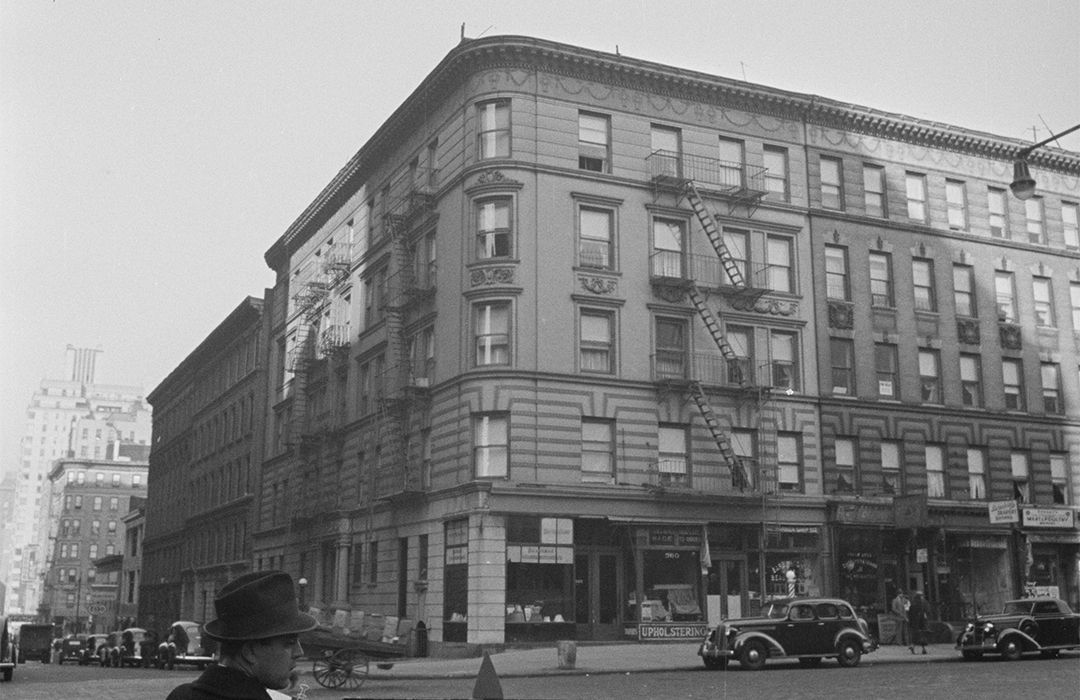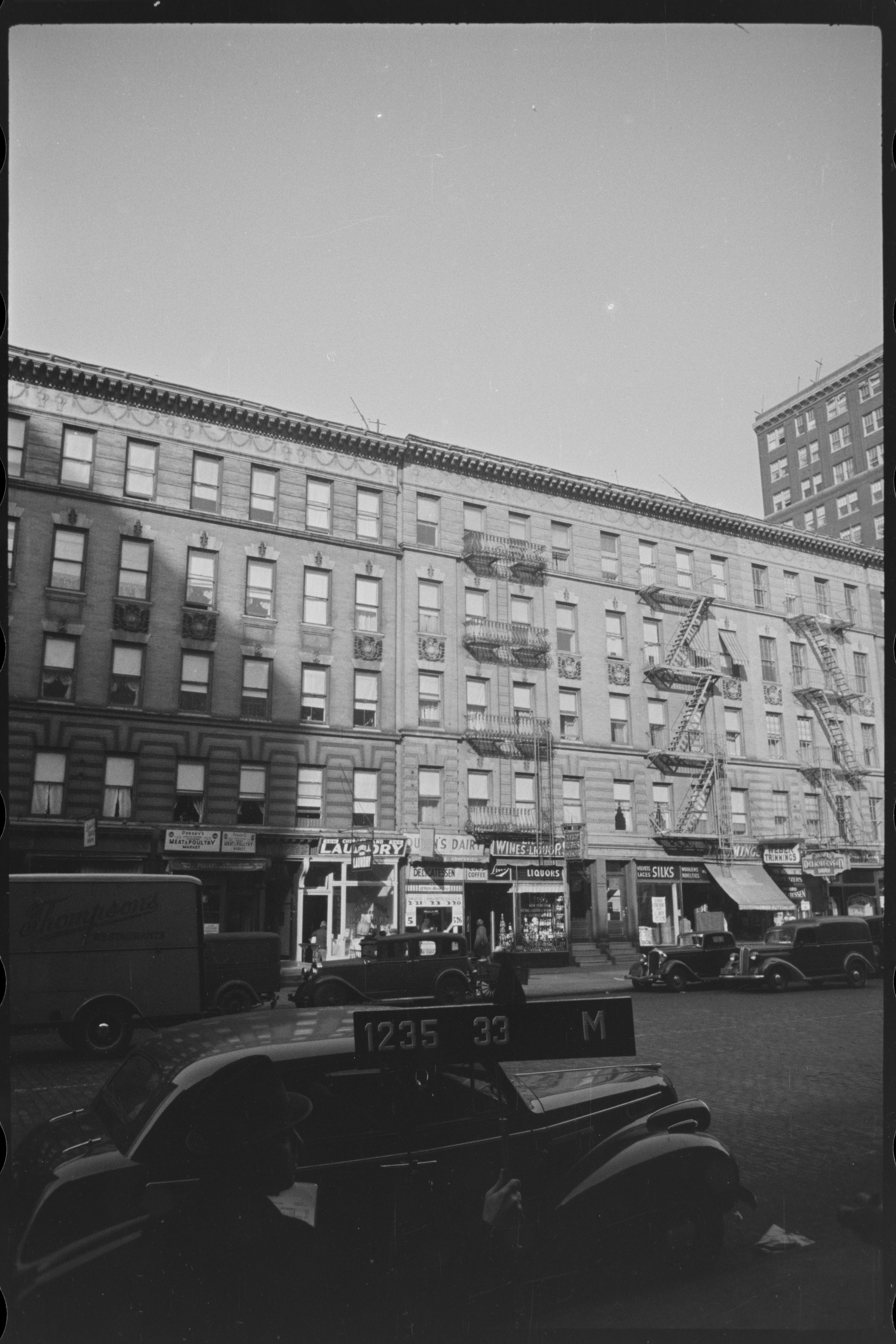
560-564 Amsterdam Avenue
by Tom Miller
In February 1895, architect Henry Anderson filed plans for Morris Steinhardt and Edward Hirsh for “three five-story brick and Connecticut brownstone flats” on the western blockfront of Amsterdam Avenue between 87th and 88th Streets. Only a month later, however, the Record & Guide reported that Hirsh and Steinhardt had sold the parcel to builders Peter Wagner and Robert Wallace, “for immediate improvements.” Interestingly, the new owners hired architect George F. Pelham to design the additional buildings that would fill the block. Whether he tweaked Anderson’s original plans is unclear, but the resultant structures were architecturally unified.
The residential entrances of the corner buildings were on the side streets—at 201 West 87th and 200 West 88th Street. Engaged porticos with paired Ionic columns sat above a flight of steps. Their entablatures were decorated with swags and shields. The Amsterdam Avenue entrances were spaced between storefronts. The upper four stories of beige brick were decorated with terra cotta. Bands of Greek key designs created a striated effect at the second floor and highlighted the splayed lintels. At the third and fourth floors were robust cartouches and keystones embellished with torches.
The apartments contained seven rooms and a bath. An advertisement boasted uniformed hall boys (on hand to carry packages, deliver mail and such). Rents ranged from the equivalent of $1,590 to $21,20 per month by 2024 conversions.
The buildings filled with upper-middle-class tenants. Among the initial residents of 201 West 87th Street was attorney Charles Barrett Place. Born in New York City in 1835, he moved to Elizabeth, New Jersey in 1860 upon marrying Mary Whitehead. Associated with several railroad companies, he returned to New York in 1894 and moved into the new apartment building when it opened.
Although surprised, she said he “presented such a roseate hue of what my life with him would be that I accepted the offer.”
Another of the building’s first tenants was Antonio H. de Paula-Coelho, director of the North American and Brazilian Steamship Company and editor of O Brazile E Os Estados Unidos (Brazil and the United States). He had served as a colonel in the Brazilian Army. The Sun said, “Upon the death of his father he inherited a large estate, and his first act was to set free 400 slaves.”
On April 6, 1897, The Sun reported that he had been sued by his “stenographer and typewriter,” Marie H. Hannemann for $10,000 for breach of promise of marriage. The article said, “She is 21 years old, and lives with her parents…The defendant, who is about 40 years old, six feet and weights 230 pounds, lives, at 201 West Eighty-seventh street.” Hannemann said that two days after being hired, Paula-Coelho proposed to her. Although surprised, she said he “presented such a roseate hue of what my life with him would be that I accepted the offer.” When the wedding day came and went, the jilted bride’s sister, 19-year-old Bertha Hannemann went to see Paula-Coehlo on January 2, 1897, “to see what his intentions were.” The editor told her that Marie “was crazy” and told Bertha that he loved her and not Marie and attempted to convince her to elope with him. He ended up, not surprisingly, marrying neither sister.
A variety of stores lined the avenue block. In 1902 the Hygrade Wine Co. store occupied 572 Amsterdam Avenue, replaced the following year by the Gallagher Stores wine shop. On July 21, 1914, a fire started in the basement. The Evening World reported that “Peter, a black cat belonging to J. Lessler, a wine and liquor dealer,” and firefighter John Hasting were both “overcome.” While the fire was extinguished with little damage, Hasting had a narrow escape. The article said a passerby “was trying to force whiskey down his throat when Deputy Chief Clark reached him.” It noted, “All firemen know that whiskey in smoke cases is likely to prove fatal.”
The would-be good Samaritan told him, “That’s all right. I know what I’m doing. I’ve treated many such cases. I’m an undertaker.”
Chief Clark responded, “Well, if I let you keep on you’d have another customer.”
The article mentioned, “Peter was resuscitated, too.”
Emil Roller, a German immigrant, lived at 201 West 87th Street in 1911, as did John and Martha Hundt. Roller not only operated the Roller Pharmacy at 574 Amsterdam Avenue, he and the Hundts owned that building. He nearly lost his business during World War I when his name landed on the Government’s list of “Brewing and Liquor Interests and German Propaganda.” He emerged from the ordeal unscathed, however, and ran his drugstore here until the Depression years.
Sculptor Charles Akers lived at 201 West 87th Street in the first years of the 20th century. Born in Hollis, Maine in 1835, he studied in Rome. He published the first volume of his autobiography in 1906 and was working on the second volume when he died in his apartment on September 16.
A resident of 201 West 87th Street was involved in a shocking incident in 1917. Beatrice Estes Weille, who was 28, saw an advertisement in the New York Herald on November 21, which offered “good pay to young women willing to do secret service work.” She met Alfred E. Lindsay at the Hotel Astor. He told her that the United States Secret Service had authorized him to pay young women $100 per week to “wring secrets from suspected spies.” The method of wringing out secrets was sex.
Beatrice refused and, suspicious, notified Assistant District Attorney James E. Smith. He instructed her to contact Lindsay and tell him she had reconsidered the offer. Two undercover detectives armed with a recorder captured the conversation. On June 15, 1918, the New-York Tribune reported that Lindsay had been indicted on a charge of white slavery.
Deutsch closed the door and went back to bed.
The World War II years saw a decline in the neighborhood. In 1941, 200 West 88th Street was converted to 11 single room occupancy units per floor. The building at 201 West 87th Street, described by the courts as a “rooming house,” had already been divided into 10 and 12 apartments per floor. In July 1952, the owner, Joseph Cohen, was indicted for overcharging of rents.
Jackok Deutsch lived in room 414 of 201 West 87th Street in 1966. Next door, in room 412, lived Malachi Jackson and Lonnie Chambliss. Early on the morning of May 28, Deutsch “heard a record player and some hollering from Room 412, which awakened him from his sleep,” according to court papers later.
Someone knocked on his door. Deutsch opened it and “saw Lonnie Chambliss standing there naked, with blood on him.” Deutsch closed the door and went back to bed.
Shortly afterward, at about 4:40 in the morning, Patrolman Scniele saw Chambliss on the street, “naked and bloody, with his hands tied behind his back.” The officer put him in his patrol car and took him to St. Luke’s Hospital. In the meantime, the body of Malachi Jackson was on the floor of room 412. Both men had been tied up and stabbed by Robert McCoy who later said he “was high on goof balls” and that he had argued with “the fags” over money, “got a knife and began stabbing away.” He was convicted of first-degree murder.
At the turn of the century, 201 West 87th Street was known as the Central Park West Hostel, and 200 West 88th Street was called the Ardis Commune. The latter building was given a brutal sixth-floor addition in 2010. Demolition permits were filed in 2024 for the blockfront. A proposed 18-story building will replace the 1896 grouping.
Tom Miller is a social historian and blogger at daytoninmanhattan.blogspot.com



